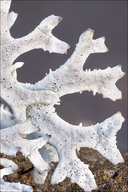|
|
click photo for larger file

Pseudevernia furfuracea
Tree Moss
|
Photographer: Dr. Amadej Trnkoczy
ID: 0000 0000 0218 0302 (2018-02-05)Copyright © 2018 Dr. Amadej Trnkoczy
|
|
INFORMATION PROVIDED WITH THE PHOTO
|
date of photo Jan 28, 2018
latitude 46.36026 longitude 13.70262
View on Google Maps.
location
Lower Trenta valley, right bank of river Soča; between villages Soča and Trenta; near Trenta 2b cottage, East Julian Alps (Posočje, Slovenia)notes Slo.: navadni rogovilar - syn.: Parmelia nuda (Ach.) Gyeln., Parmelia furfuracea (L.) Ach., Hypogymnia furfuracea (L.) Krog, Evernia furfuracea (L.) W. Mann, Borrera furfuracea (L.) Ach., Lobaria furfuracea (L.) Hoffm. - Habitat: abandoned pastures with scattered trees; moderately inclined mountain slope, south-east aspect; relatively warm and dry place; calcareous ground, sunny place; exposed to direct rain; average precipitations ~ 3.000 mm/year, average temperature 7-9 deg C, elevations 600 m (1.950 feet), alpine phytogeographical region. Substratum: bark of smaller branches of a stand-alone, recently cut down Juglans regia. Comment: Pseudevernia furfuracea is a very common foliose-shrubby lichen in general and also in Trenta valley, particularly on higher elevations. It climbs up to the tree border elevations. It can be found on bark of deciduous trees as well as on conifers and sometimes also on rocks. Pictures show a young, still small specimen in damp state. Hence the thallus is almost white. Grown up specimens are darker - gray or brownish-gray, often densely covered with isidia and dark brown to black underneath. When old they sometimes become of bizarre shapes appearing completely different from these pictures. Apothecia are rare. The species is very variable. Probably the best trait for determination is its growth. Terminal thallus strap-shaped lobes divide widely divergent and quite strictly dichotomously. All terminal lobes remain in a single plane and they are rather short. When dry the edges of the straps curl strongly inwards, sometimes completely covering the lower, black side of the straps. A very similarly looking habit has another common lichen - Evernia prunastri (L.) Ach.. But, its lobes are usually greenish, often net-veined above and white beneath (also when old). Lichen was 3 to 4 cm tall growing on a relatively thin branch. 5% KOH reaction on thallus was yellow-green. Only one specimen has been found on this tree. Otherwise about 25 different lichen species have been spotted on it. Ref.: (1) C.W.Smith, et all, The lichens of Great Britain and Ireland,The British Lichen Society,(2009), p 759. (2) V. Wirth, R. Duell, Farbatlas Flechten und Moose, Ulmer, (2000), p 36. (3) V. Wirth, Die Flechten Baden-Württembergs, Teil. 2., Ulmer (1995), p 782. (4) F.S. Dobson, Lichens, The Richmonds Publishing Ca.LTD (2005), p 368.camera Nikon D700 / Nikkor Micro 105mm/f2.8/
contributor's ID # Bot_1110/2018_DSC0742 photo category: Fungi - lichen
|
MORE INFORMATION ABOUT THIS FUNGUS
|
| common names
Tree Moss (photographer)
View all photos in CalPhotos of Pseudevernia furfuracea Check Google Images for Pseudevernia furfuracea |
|
The photographer's identification Pseudevernia furfuracea has not been reviewed. Click here to review or comment on the identification. |
|
Using this photo The thumbnail photo (128x192 pixels) on this page may be freely used for personal or academic purposes without prior permission under the Fair Use provisions of US copyright law as long as the photo is clearly credited with © 2018 Dr. Amadej Trnkoczy.
For other uses, or if you have questions, contact Dr. Amadej Trnkoczy amadej.trnkoczy[AT]siol.net. (Replace the [AT] with the @ symbol before sending an email.) |
|
|
